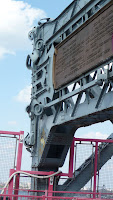 ider Art Fair, which is in a building near the Empire State Building. The silver trim on the Empire State was gleaming in a way the forced you to look at the pattern and really see the way the parts work together -- shiny silver, warm red, rich cream, and bluish glass all leading up to that gorgeous, machine-age spire.
ider Art Fair, which is in a building near the Empire State Building. The silver trim on the Empire State was gleaming in a way the forced you to look at the pattern and really see the way the parts work together -- shiny silver, warm red, rich cream, and bluish glass all leading up to that gorgeous, machine-age spire.As much as I grew to love the Space Needle after a period of not liking it, I still love the Empire State more -- it starts from a strong base and rises gradually to a point so it looks totally supported and strong, whereas the Space Needle has a spindlier build and from some angles looks as if it can't hold the weight of its oversized head. Unless you're standing right under the Needle and you can see its powerful splayed legs, it can seems like a pumpkin on a stick.
Another reason I was paying special attention to the Empire State Building today: I had just read that the new skyscraper in Dubai is twice as tall as New York's tallest. That is breathtaking height that you can only really appreciate when you're standing next to a building that's half as tall.
But enough amateur criticism of phallic architecture. Back to outsider art. The pieces in the show were from all over the country, in lots of different styles and materials -- crayon, sheet metal, wood, pencil, mud, cloth, wire, thread, even ramen noodle packages. The dominant themes were religion, obsession, peculiar ideas of beauty, and the overwhelming and deep desire for self-expression. The generally accepted notion of outsider art is that it's done by untrained artists, some using found materials, others using the tools that any artist would use. But what really struck me at this show was how confident these artists are. Some are developmentally disabled or mentally ill or just people who live away from the mainstream. But they know what they want to say and they find a way to say it. You can't deny the power of that, whether you like the art or not. I really love it, and I know Ian does too. "I'm inspired," he said as we parted ways at Herald Square.
What's really crazy about this art is that some of the outsiders are now true insiders -- collected and priced just like "real" artists. Some scrap of paper on which a guy outlined a dog in watercolor can sell for 100 Gs. Bill Traylor (painter of the red snake in the picture), Mose Talbot, Henry Darger,
 Morton Bartlett (he made the doll and staged the photo you see here) -- just some of the big-name outsiders.
Morton Bartlett (he made the doll and staged the photo you see here) -- just some of the big-name outsiders.As with other art, the monetary value didn't seem to have a lot to do with the quality of the work -- it's something more mysterious and in a way a metaphor for life in New York. What's worth spending my dollar on? That's what you can find yourself asking over and over here. A $15 sandwich or a $40 cab ride can be a bargain -- if the moment is right and you're hungry or tired enough.
But I'm meandering here, so I think I'll sign off.














